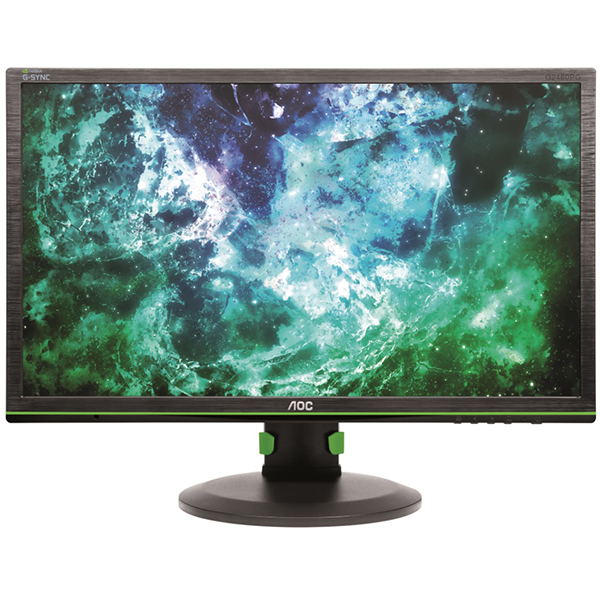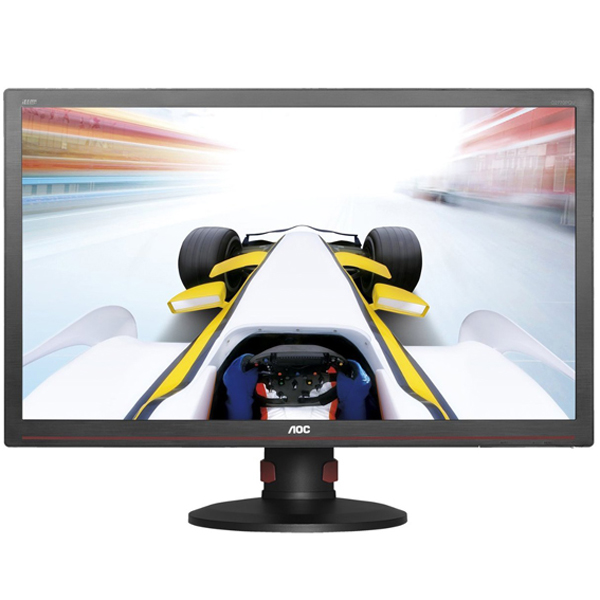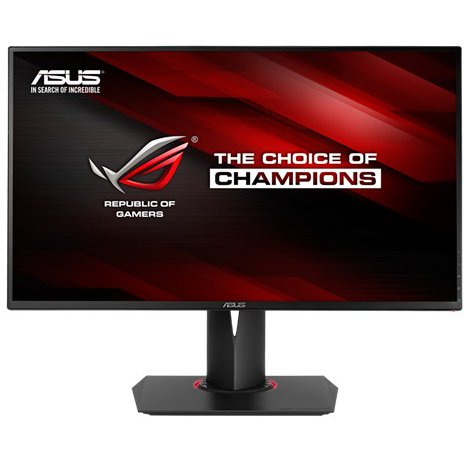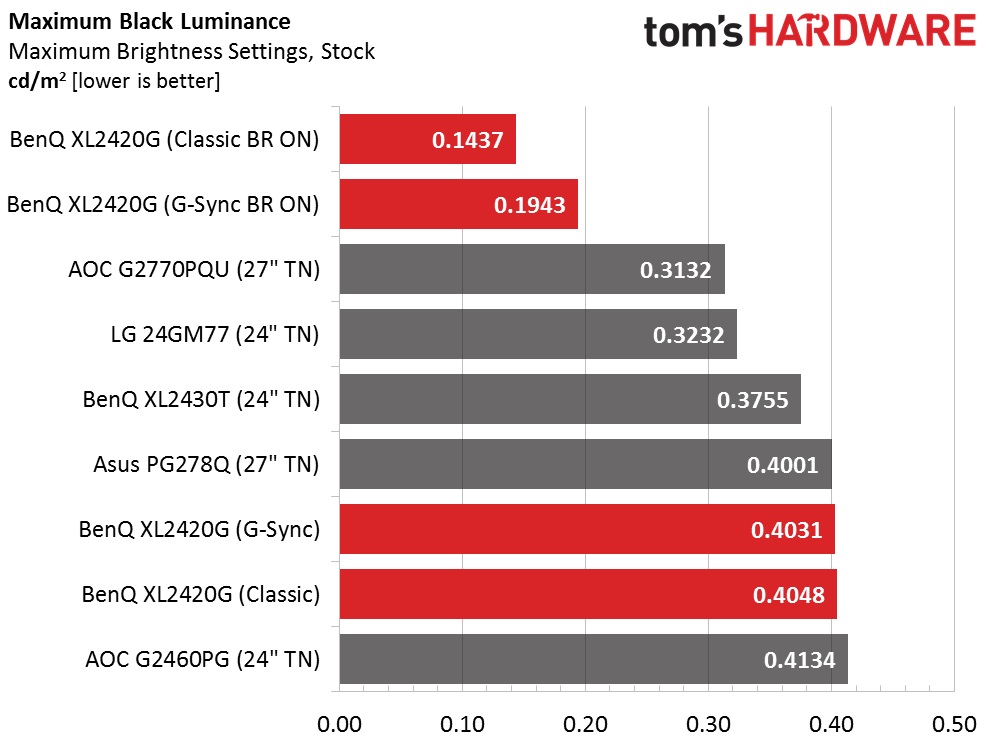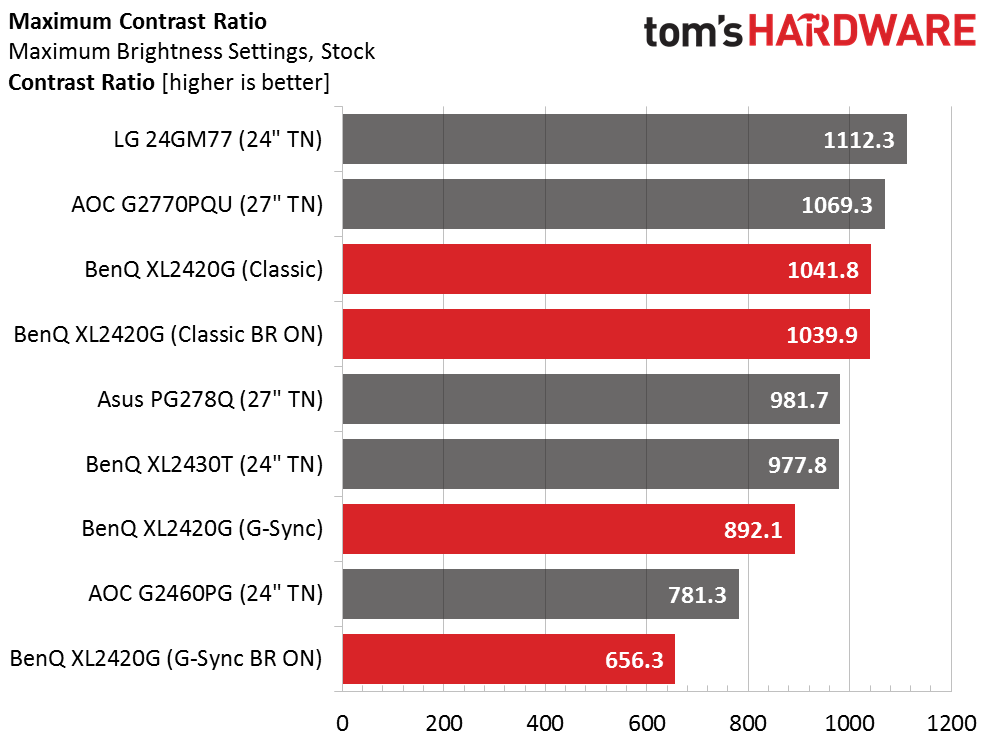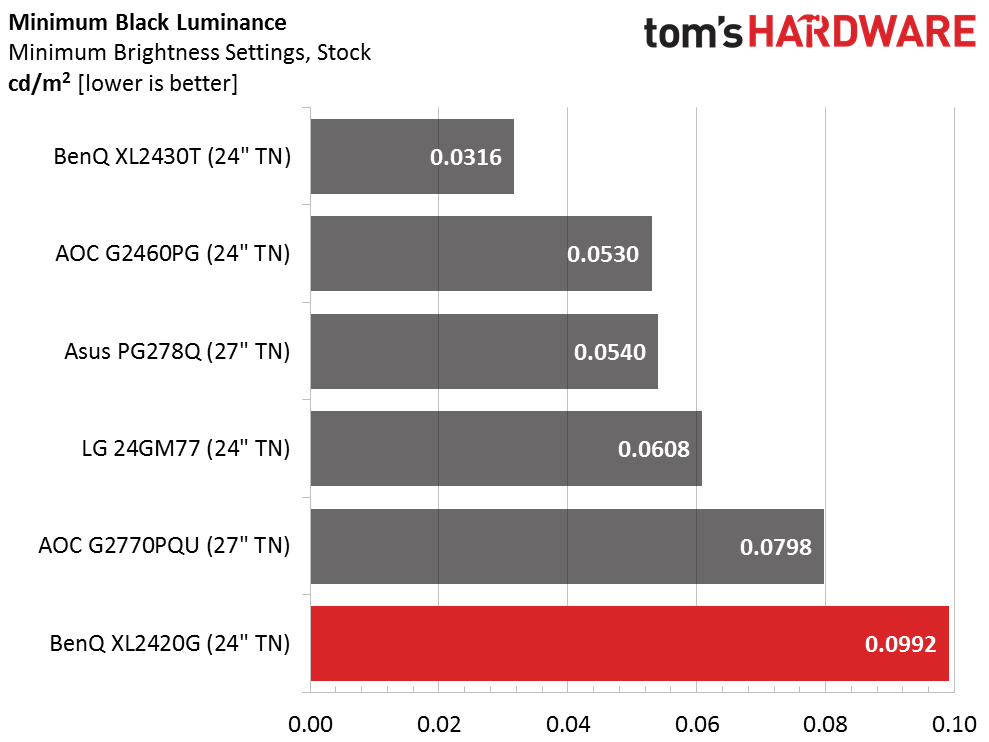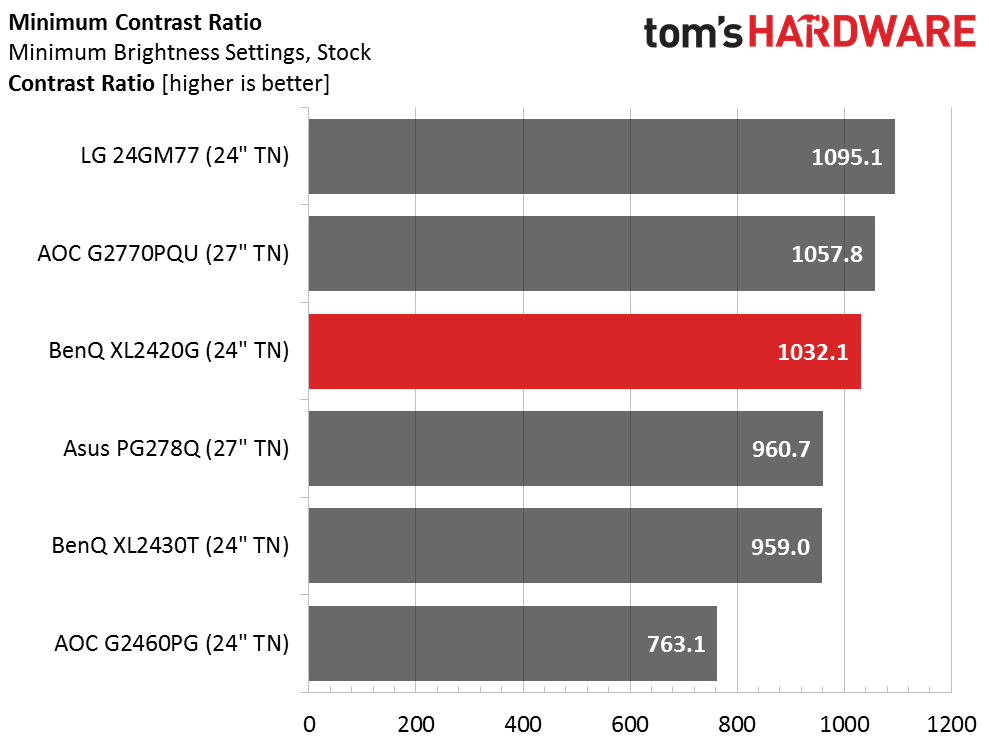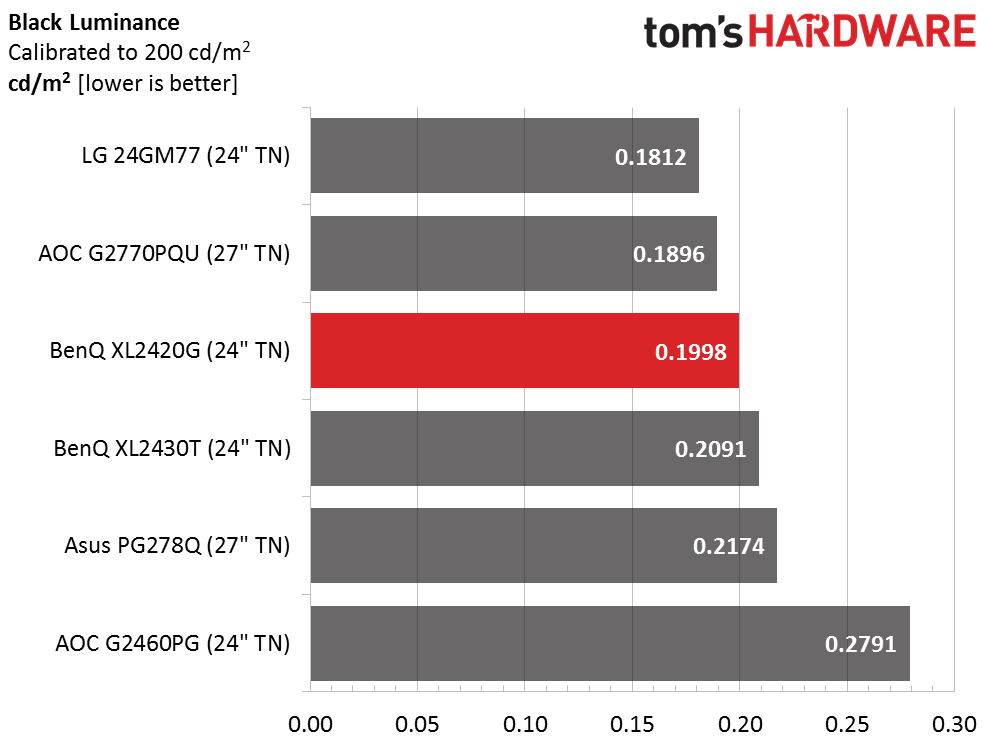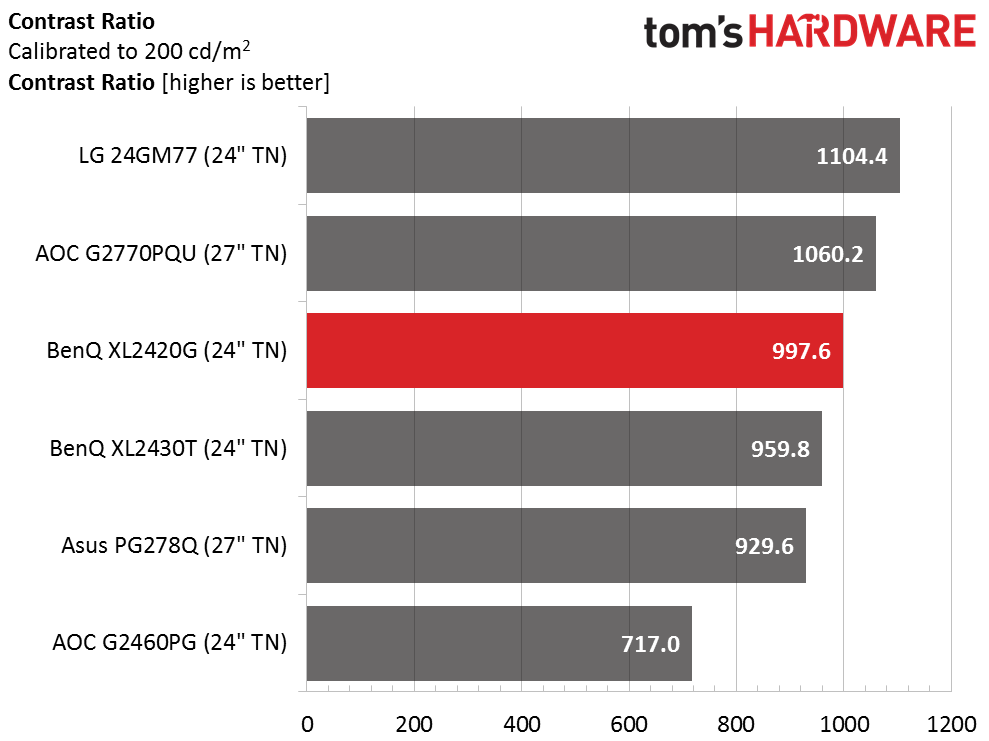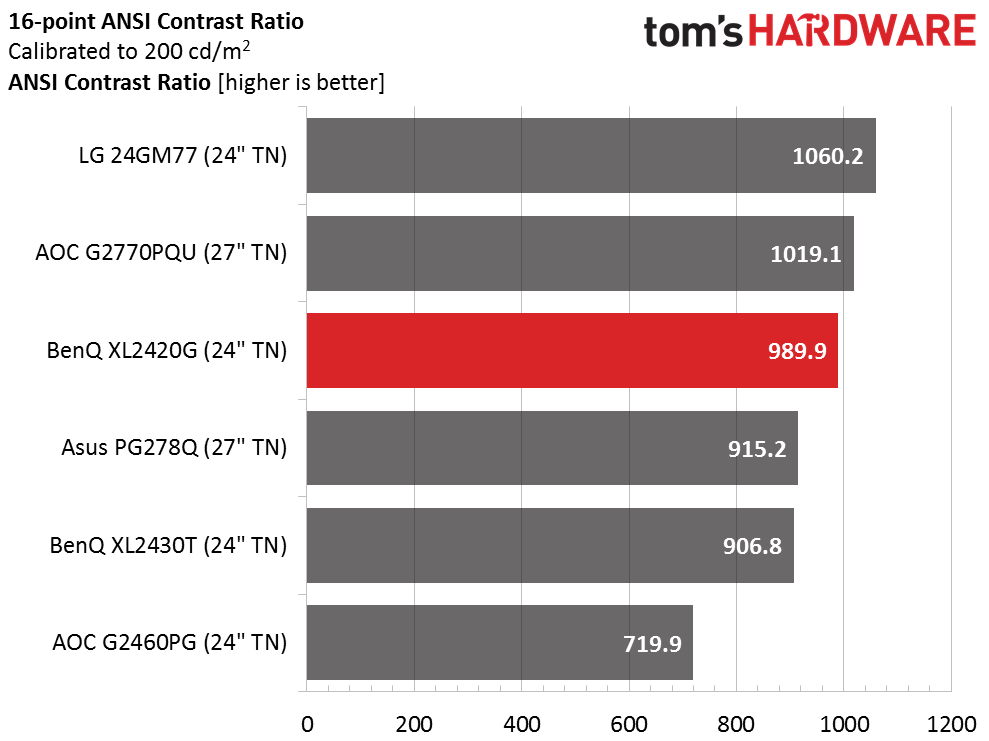BenQ XL2420G G-Sync Monitor Review
Even though FreeSync is starting to appear, G-Sync is still the go-to tech for gamers seeking an image free of frame-tearing. Today we’re checking out BenQ’s latest feature-laden display – the 24-inch XL2420G.
Why you can trust Tom's Hardware
Brightness And Contrast
To read about our monitor tests in-depth, please check out Display Testing Explained: How We Test Monitors and TVs. Brightness and Contrast testing is covered on page two.
Uncalibrated – Maximum Backlight Level
We can’t quite fill the group with G-Sync-capable monitors. But the empty spaces are occupied by 24-inch 144Hz screens, including BenQ’s XL2430T, LG’s 24GM77 and AOC’s G2770PQU. G-Sync is represented by the Asus PG278Q (ROG Swift) and AOC G2460PG.
Because of the XL2420G's dual-mode nature, we’re showing data from both the G-Sync and Classic modes. There are significant differences in light output, contrast, gamma and color. Fortunately you can set up each mode independently if you wish. We’ll walk you through everything.
The highest light output comes from Classic mode with the Brightness option maxed. Ordinarily we’d say that’s a good thing when using blur reduction. But in the XL2420G’s case, the hit to output borders on tremendous at 65 percent.
There is a pulse-width adjustment in G-Sync mode, but it can only be lowered, which means the monitor becomes even darker. While the output levels are still useable, you’ll have to turn your room lights down (or off) for best results.
It stands to reason that the best black levels occur when blur reduction is turned on. If you like to play in the dark, the image looks pretty good with detail-rich shadows. Thanks to accurate low-end gamma, it’s easy to see the darker areas of your content.
In Classic mode, contrast is unaffected by blur reduction. The same is not true in G-Sync mode, however. You lose about 14-percent contrast without blur reduction and almost 37 percent with it. The upside is that, at high refresh rates, you can live without the feature. And it’s well worth sacrificing for better contrast. We prefer using the XL2420G in its 144Hz mode all of the time.
Get Tom's Hardware's best news and in-depth reviews, straight to your inbox.
Uncalibrated – Minimum Backlight Level
The above result represents Classic mode with blur-reduction turned off. If you turn it on, peak output drops to 35.8429cd/m2, which is a little too dim for us. Our favorite screen for dark-room gaming is Asus' ROG Swift and its ideal 51.9157cd/m2 minimum output.
A bright backlight means higher minimum black levels. A result of .0992cd/m2 is still pretty low, however. What's important is that contrast remains consistent, as you’ll see in the next chart.
A result of 1032.1:1 reflects minimal change from the maximum. And that holds true for both the Classic and G-Sync modes. You can set the backlight to your preference, maintaining the same image depth and contrast regardless of output.
After Calibration to 200cd/m2
Our calibrated output results come from the Classic mode. Without blur reduction, G-Sync mode offers about the same black level, albeit with less peak output. That explains the difference in overall contrast.
Calibrated contrast is only four percent lower than the max result in Classic mode. G-Sync mode contrast is 857.9:1, reflecting close to the same 14-percent drop we saw above. All of the monitors are pretty similar in this metric. You won’t see a huge difference when comparing them side-by-side. Of the G-Sync-capable screens, Asus offers the best calibrated contrast. But LG’s 144Hz model takes the overall prize.
ANSI Contrast Ratio
BenQ uses a good-quality panel in the XL2420G. Such high ANSI contrast makes this a great display for gaming and video content alike. The only screen lagging here is AOC's G2460PG.
Current page: Brightness And Contrast
Prev Page OSD Setup And Calibration Next Page Grayscale Tracking And Gamma Response
Christian Eberle is a Contributing Editor for Tom's Hardware US. He's a veteran reviewer of A/V equipment, specializing in monitors. Christian began his obsession with tech when he built his first PC in 1991, a 286 running DOS 3.0 at a blazing 12MHz. In 2006, he undertook training from the Imaging Science Foundation in video calibration and testing and thus started a passion for precise imaging that persists to this day. He is also a professional musician with a degree from the New England Conservatory as a classical bassoonist which he used to good effect as a performer with the West Point Army Band from 1987 to 2013. He enjoys watching movies and listening to high-end audio in his custom-built home theater and can be seen riding trails near his home on a race-ready ICE VTX recumbent trike. Christian enjoys the endless summer in Florida where he lives with his wife and Chihuahua and plays with orchestras around the state.
-
Wisecracker I can understand why the display folks thread lightly, here. This price point is a minefield and miss-mash of tech. This monitor might be a bargain at $300.Reply
Otherwise, $500-$600 is Eyefinity/Surround, HD Projector, 60-inch Plasma TV territory. It's a tough sell for a display port-capable monitor these days in Adaptive/G -Sync, being that we are only moments before the flood.
And, the market is not in the high-end, at least, not for long. It's back where us poor slubs with 'pitiful' $200 gaming cards :lol: need the help.
-
bogda Finally a G-Sync monitor with more inputs than one DP. Now give me 1440p resolution and price below 500 and I will consider it.Reply -
DarkSable Just throwing out there - saying that the brighter the monitor the better is absolutely far from the truth. If you're in an office environment under florescent lighting, then sure, but if you're interested in a gaming computer, it's probably in your room or a den, and, well... brighter is only better if you only game at night, or have every possible light on while you do.Reply
From all the gripes about how the monitor gets so dim, that's actually a HUGE benefit for me - nobody every bothers to test what the minimum brightness a monitor can achieve, and many monitors, especially gaming monitors, fail miserably. I'd much rather have less eye strain than picture-perfect colors when I'm gaming at night. -
PaulBags DP has better bandwidth, so why does the HDMI here have better contrast and colour accuraccy?Reply -
Shankovich Here's that $200 nVidia premium kicking in. Could have made it IPS or 1440p guys come on...Reply -
blakphoenix I'm sorry but there is no way this monitor could be classed as having "professional-level color accuracy". For starters it doesn't even get 100% sRGB, let alone the terrible sub 70% AdobeRGB performance. Is it good enough for games? It may well be. Is it professional level colour? Not even close!Reply -
bystander ReplyJust throwing out there - saying that the brighter the monitor the better is absolutely far from the truth. If you're in an office environment under florescent lighting, then sure, but if you're interested in a gaming computer, it's probably in your room or a den, and, well... brighter is only better if you only game at night, or have every possible light on while you do.
Brightness does have one important use; ULMB. In ULMB, because the backlighting pulses, it causes these monitors to be very dim. Extra brightness helps to counteract this issue, but I do agree, testing the minimum might be useful, as there are some people out there that have to play at nearly the lowest levels due to headaches.
From all the gripes about how the monitor gets so dim, that's actually a HUGE benefit for me - nobody every bothers to test what the minimum brightness a monitor can achieve, and many monitors, especially gaming monitors, fail miserably. I'd much rather have less eye strain than picture-perfect colors when I'm gaming at night. -
TechyInAZ Wow very sweet for a monitor. I would highly consider this monitor if I can afford it. Since I use my computer for both work and play.Reply
However, for that price I'm disappointed it's only 1080P. I hope they come out with a free sync 1440P version that's cheaper than this monitor.
